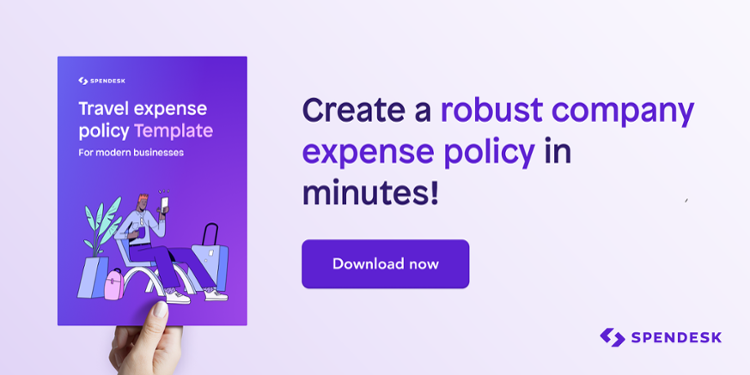)
Writing a company travel and expense policy is a simple enough task - if a little tedious. But there's a big difference between a policy that technically ticks all the boxes, and one that people actually use.
In most cases, these internal policy documents are forgotten about the moment they're produced, with most employees just doing their own thing.
That's not what you want. If you're preparing or updating your expense policy, there are a few ways to make it more effective. We've compiled eight excellent tips that should help you write a document that your teams love.
Let’s start with, in my opinion, the most important factor to keep in mind.
What is a T&E policy?
T&E stands for "travel & expense," and this policy governs how teams spend company money on travel and other relevant expenses. Most often, employees themselves make these purchases, so a clear policy is essential.
The most common T&E expenses occur during business trips. This includes the travel itself (flights, trains, and taxis), accommodation, food, and work-related incidentals. Because the entire trip is for work, these items are considered work expenses where they otherwise might not be.
Your T&E policy should cover all instances when employees work away from the office (but excluding remote work - you'll need another policy for that). So it's not only limited to international or intercity travel, and it doesn't even need to be overnight.
So that's your basic definition. Now, here are 8 tips to make your policy as effective as can be.
1. Write it like most people won’t read it!
Because they won’t.
This is by far the most frustrating aspect of documenting processes, and it’s also something you can’t avoid. Even if the policy is the most important thing in the world for your job, most employees will probably forget it even exists.
So what does this mean in practice?
First, you have to write for skim-readers. Long preambles and introductions from the CEO don’t help here. The best things you can include are:
A table of contents
Bullet points, flowcharts, and tables that guide the eye to anything crucial
Clear headings and important details in bold
Also make sure you reference it regularly around the company, and keep the policy somewhere people will find it easily. Or even better, build it into your automation tools (more on this later).
And even though it’s a technical document, try to write it “for dummies.” Short sentences, simple words, and nothing that people have to look up in the dictionary.
Complex language doesn’t make the policy seem more authoritative - it just ensures that fewer people will follow it.
2. Be “clear, fair, and unambiguous”
On top of being easy to understand, the policy also needs to avoid ambiguity. If employees aren’t sure whether they need to do this or that, they’ll probably wind up doing neither.
Complete Controller says that it all comes down to ease of use. “When formulating a business expense policy, the one thing that should remain a priority is ease of communication. After all, you don’t want your employees to go through the company textbook every time they have a question just to understand the business expense policy. The key here is simplicity.”
Fairness is also important. If at all possible, it’s best to give all employees - regardless of seniority - the same experience. It’s up to you whether managers travel business class and other employees fly economy, but if that’s the case, you’re asking for protests.
3. Include every important detail

Naturally, a good expense policy sets out all the rules you expect employees to follow. Which means if you leave important things out of it, they’re not going to behave how you wish they would.
As our friends at TravelPerk write, “when creating a travel policy, you have an explicit responsibility to ensure it’s as comprehensive as possible. After all, it will be the go-to for any and all questions your employees have on anything travel.”
TravelPerk’s list of must-haves includes:
Where and how to book travel. As in, which websites, travel agents, or internal knowledge pages they should use.
Tools they should use in the booking process
The criteria for approving or rejecting an itinerary
How expense reimbursements work
Suitable flights, including class, rough budgets, and any other limits
Rail travel, and when it should be used over flights
Permissible hotels, including the star class allowed based on location along with allowable and non-allowable incidental expenses
General guidelines on rental cars, ground transportation, ride-hailing services like Uber, and personal car usage
Food allowances, because everyone needs to eat!
You may of course include other factors specific to your own company. But without all of those above, your policy won’t be complete.
)
4. Focus on the “Five W's”
This one might remind you of English class. Another way to make sure your policy is complete is to ask the same key questions you learned as a child.
Every travel and expense policy needs to set out:
Who is covered by the policy? Who is not covered? Who can approve requests?
What is covered by the policy? What is included? What is not included?
When should travel requests be submitted? When should bookings happen? When should travelers request an exception? When should expense reports be submitted?
Where can employees find resources in a travel emergency? Where can they ask questions about the policy? Where can they find the policy?
Why does this policy exist? Why is it beneficial? Why should employees follow it?
These aren’t mindblowing, but once your policy is prepared it makes sense to run back through and make sure they’re all answered.
5. Automate if possible
Firm of the Future writes that “expense management software allows managers to set policies for employees, including limits on travel rates for airlines and hotels, as well as preferred vendors. The software also can remind employees of deadlines for report submission. Further, it can speed the approval and reimbursement process by integrating with online purchasing systems, invoice management and reporting.”
In the same article, the authors share a Runzheimer International study which found that companies using automated software actually spend 27% than those with paper expense processes. And with the advancements in automation to date, it’s fair to assume that that figure will have increased greatly.
Calculate how much expense automation could save your company.
The beauty of automation is that it builds your expense policy into the process. As we wrote above, you can’t assume that anybody is actually going to read the thing. So when you can build it into your tools, employees end up following procedure by default.
6. Save room for bleisure

This is a small point, but it’s one that employees will care about a lot. When traveling for work, what are the rules for adding extra personal time on the side?
In practice, this means explaining clearly whether or not the company will still pay for flights, accommodation, and any other extras. And if the answer is “sometimes,” you need to set out these conditions.
If you’re able to, bleisure travel is a nice gesture to offer to employees that doesn’t have to cost you a cent.
7. Include a time frame for expense claims
We’re not big fans of expense reports. But if you’re going to use them, you need to set out the rules clearly in your T&E policy.
Of course, this should include the kinds of expenses that will be reimbursed and any limits you choose to impose. But crucially - if you want to keep your financial books in order - you should also set a time frame.
As Orba details, “you will want to include a schedule for claiming expenses. This should include how quickly an expense should be claimed by your employee and also how quickly after claiming the expense the employee should expect reimbursement from your company.”
Try to be fair to employees here. After all, these are company expenses and you don’t want to leave team members out of pocket if they miss the deadline.
But equally, you want to give them an incentive to file their paperwork as quickly as possible. And a clear cutoff may be just the thing.
8. Update regularly
As we’ve written before, your expense policy is a living document. You can’t simply write it, file it somewhere, and leave it untouched.
As the company evolves and new people arrive, travel and expense conditions are bound to change. And you need to be prepared to keep the policy up to date.
At the very least, this will keep you in line with any rates updates HMRC or the IRS make. You don’t want to shortchange employees if they’re entitled to updated amounts.
Put these practices to paper
Or better yet, to software. As we touched on briefly, modern expense policies belong in digital form, rather than print-outs in file cabinets.
And to go one step further, look for travel management and expense management tools that bake your policy in. This way nobody even has to read the thing to stay on the right track.
This could be a travel booking tool that provides employees with a list of suitable (per your policy) airlines or hotels to use. It could also be a spend management platform that prevents them from going over-budget and gives their manager the right to approve before payment.
These options might life easier for the traveler because they don’t need to ask for help, and they finance teams and managers in control of company travel.
Whatever you choose, just make sure that your travel and expense policy can be understood by even the most easily-confused employees. Simplify it now, and you save yourself a mountain of questions down the road.



)
)
)
)
)